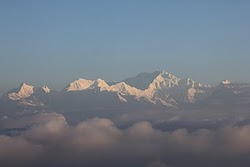Darjeeling is one of those inscrutably inimitable Himalayan resorts that defies satisfactory description in its totality. Fond memories of these daunting hills of abundant greenery blossom like a hundred-petaled marigold of multi-color hues.
Old bungalows mostly in picturesque remote areas that were built by the colonial British rulers occupy a place of pride in its history. Electricity was not available for these bungalows then, and for many decades later many such bungalows remained out of bounds for power companies to maintain the old ambiance.
One such bungalow is Lepcha Jagat. A wooden bungalow with sloping corrugated iron roof right in the midst of a dense forest of oak, rhododendron, pines and other Himalayan flora, and no electricity.
Often obstinate rain accompanied by strong wind collecting sighs, whistles and drum beats from the hill slopes embrace the bungalow, wind swept foliage paste shifting shadows on every conceivable medium. Stand out in the veranda for a couple of minutes; with a cold chill running down the spine you may even regret that once you were chary about believing in the woes of a tap dancing ghost. But this one's not a ghost story.
In 1940s, a senior British official visited the Lepcha Jagat bungalow with his pregnant wife. They could not return home without experiencing a rare Himalayan view that the bungalow was famous for.
 |
| pic from - www.jkindiatrip.blogspot.com |
On a clear day one could have a bird's eye-view of the then three Himalayan kingdoms of Nepal, Bhutan and Sikkim lying side by side on a huge idyllic expanse with the snow-capped Kanchendzonga, the highest mountain in India, and third highest in the world at 8,586 meters, dwarfing everything else. At night twinkling electricity bulbs in the kingdoms gave the appearance of the sky having come down on them. This was reason enough for the British couple to reserve the bungalow for three days.
It drizzled lightly when they arrived. By night fall fog invaded the bungalow and the surrounding forest, and then soared high and kissed the low hanging black canopy of cloud. One could not distinguish where the fog bank ended and cloud bank began. Hail storm reigned the next day. Open spaces went under a carpet of white stones. The third day was no better.
Tired and disappointed, the visitors decided to give up. The official asked for the voluminous guest book, and recorded his experience. With a heavy heart and a sigh he mentioned, “It's raining even as I am leaving.”
 |
| Pic from - http://www.mobwiki.com |
The capricious Himalayan weather continued to bless some and curse others. Some bantered that the bungalow actually existed in a cloud castle, and there was nothing but rain - right, left and center. Many doubted whether it was the opposite of the fictional utopia called Shangril-La.
Much water had flown down the river Tista, two decades after India gained independence from the colonial rulers in 1947, a young foreigner went almost mad laughing in one of the worst spells of rain and hailstorm for several days at Lepcha Jagat. On his day of departure, he asked for the guest book. He marked out an earlier page by its number, and wrote, “Father, it's still raining.”
BY TAPAS MUKHERJEE
BY TAPAS MUKHERJEE



